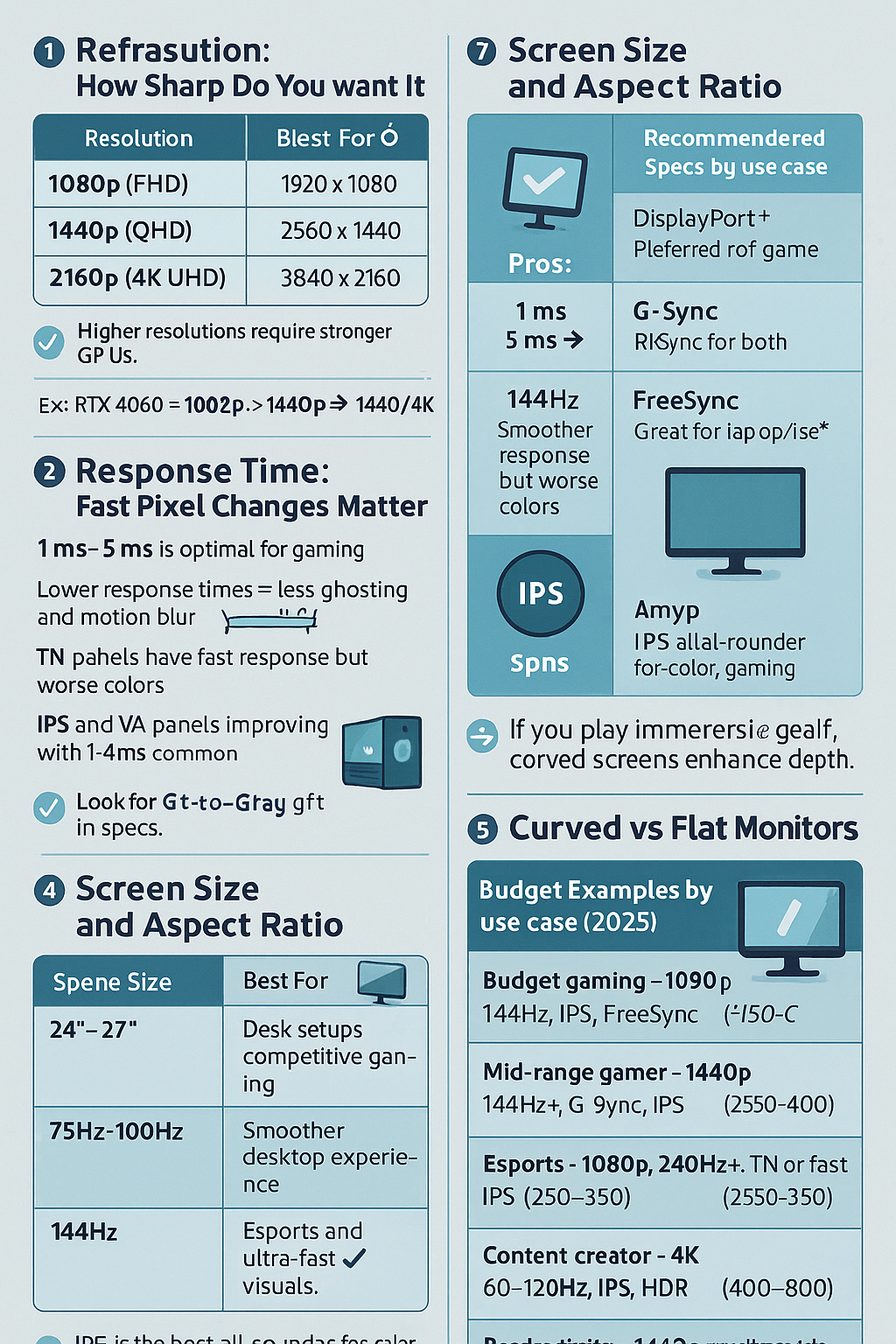A powerful PC deserves a monitor that matches its performance. Whether you’re gaming, editing, or just browsing, your monitor can make or break your experience.
In this article, you’ll learn how to choose the right monitor based on your usage, GPU, and budget — covering refresh rate, resolution, panel type, and more.
1. What to Consider Before Buying a Monitor
Before diving into specs, ask yourself:
- What will you use the monitor for? (Gaming, work, content creation?)
- How powerful is your GPU?
- Do you prefer size, clarity, or speed?
- What’s your workspace size?
These answers shape which features matter most for you.
2. Resolution: How Sharp Do You Want It?
| Resolution | Pixel Count | Best For |
|---|---|---|
| 1080p (FHD) | 1920×1080 | Budget gaming, everyday use |
| 1440p (QHD) | 2560×1440 | Balanced gaming and work |
| 2160p (4K UHD) | 3840×2160 | Creative work, high-end visuals |
💡 Higher resolutions require stronger GPUs.
Ex: RTX 4060 = 1080p/1440p, RTX 4080 = 1440p/4K
3. Refresh Rate: Smoothness for Gaming
| Refresh Rate | Ideal Use |
|---|---|
| 60Hz | Office work, casual gaming |
| 75Hz–100Hz | Smoother desktop experience |
| 144Hz | Standard for competitive gaming |
| 240Hz+ | Esports and ultra-fast games |
✅ A 144Hz monitor is the sweet spot for most gamers.
4. Response Time: Fast Pixel Changes Matter
- 1ms – 5ms is optimal for gaming
- Lower response times = less ghosting and motion blur
- TN panels have fast response but worse colors
- IPS and VA panels are improving, with 1–4ms common in 2025
Look for GtG (gray-to-gray) response time in specs.
5. Panel Types Explained
| Panel Type | Pros | Cons |
|---|---|---|
| IPS | Best color and angles | Slightly higher price, light bleed |
| VA | Great contrast and blacks | Slower response in some models |
| TN | Fastest response, low input lag | Poor viewing angles and colors |
✅ IPS is the best all-rounder for color, gaming, and work.
6. Adaptive Sync: G-Sync vs FreeSync
Screen tearing happens when your GPU and monitor aren’t in sync.
- G-Sync (NVIDIA)
- FreeSync (AMD)
Modern monitors often support both, or G-Sync Compatible with FreeSync over DisplayPort.
Check compatibility with your GPU.
7. Screen Size and Aspect Ratio
| Size | Best For |
|---|---|
| 24″–27″ | Desk setups, competitive gaming |
| 32″ | Immersive gaming, multitasking |
| 34″+ Ultrawide | Video editing, sim racing, workspace |
Aspect ratios:
- 16:9 = standard
- 21:9 / 32:9 = ultrawide / super ultrawide
- Adds screen real estate, useful for productivity
8. Curved vs Flat Monitors
- Curved (1000R–1800R): More immersive, better for ultrawide
- Flat: More accurate for work, text, and design
If you play immersive games or use multiple windows, curved screens enhance depth and reduce eye movement.
9. Monitor Ports and Ergonomics
✅ Must-haves:
- DisplayPort – preferred for gaming (higher bandwidth)
- HDMI 2.1 – required for 144Hz+ at 4K
- USB-C – great for laptops and docking
- Height, tilt, swivel adjustments for comfort
Check if the monitor includes a VESA mount (for arms or wall mounting).
10. Budget Examples by Use Case (2025)
| Use Case | Recommended Specs |
|---|---|
| Budget gaming | 1080p, 144Hz, IPS, FreeSync (~$150–200) |
| Mid-range gamer | 1440p, 144Hz+, G-Sync, IPS (~$250–400) |
| Esports | 1080p, 240Hz+, TN or fast IPS (~$250–350) |
| Content creator | 4K, 60–120Hz, IPS, HDR (~$400–800) |
| Productivity | 1440p or ultrawide, IPS, USB-C (~$250+) |
Final Thoughts
Your monitor choice directly affects how you experience your PC — from fluid gaming to pixel-perfect photo editing.
✅ For gaming: prioritize refresh rate, response time, and adaptive sync
✅ For content creation: prioritize resolution, color accuracy, and IPS
✅ For general use: balance size, comfort, and budget
Choose wisely, and your monitor will elevate every task you do on your PC.
